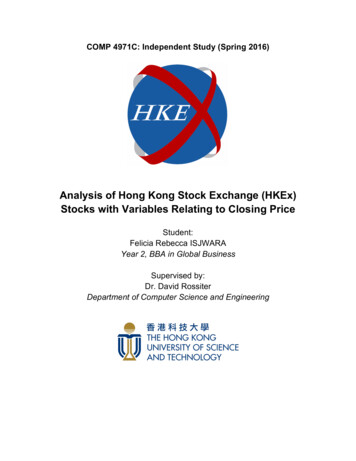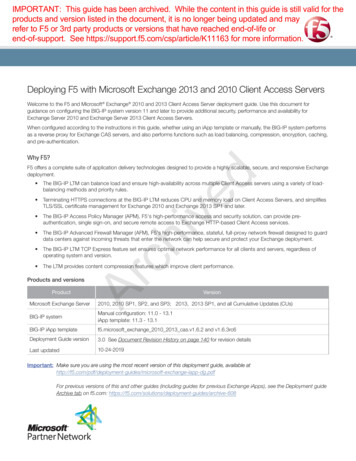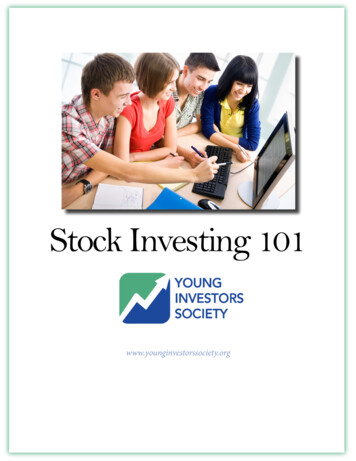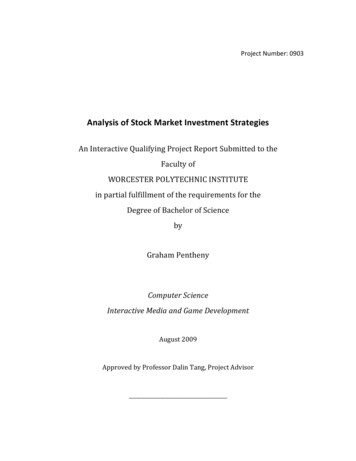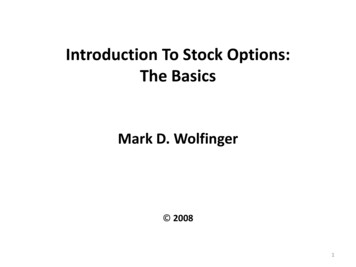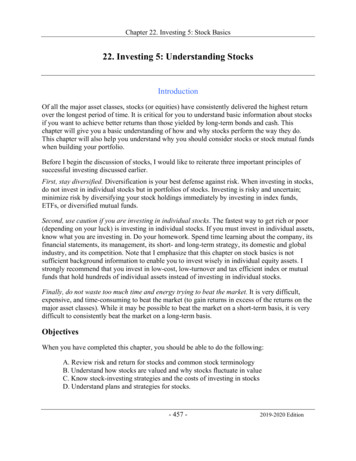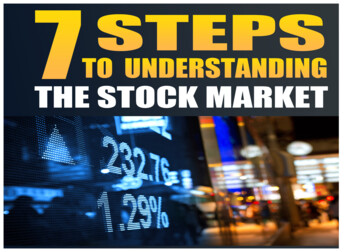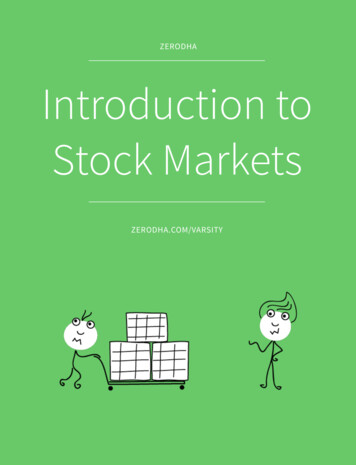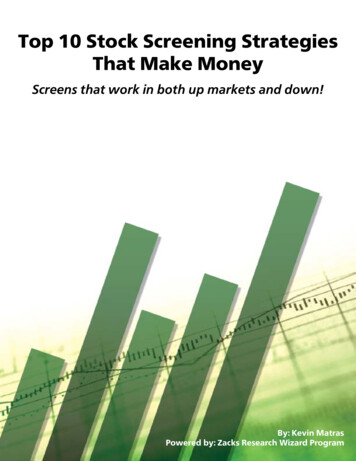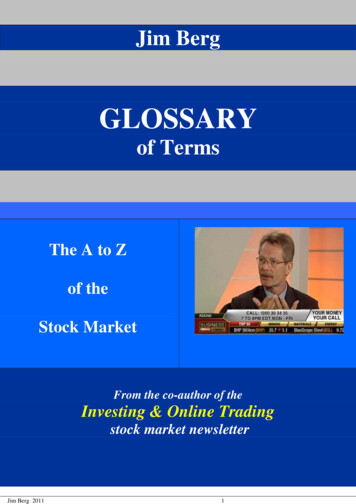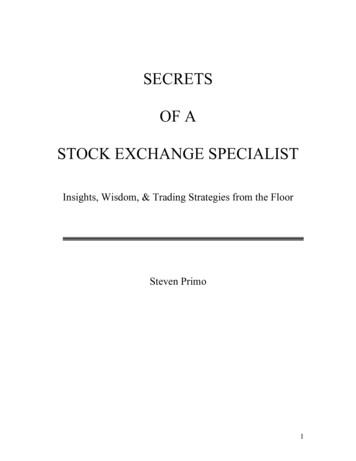
Transcription
SECRETSOF ASTOCK EXCHANGE SPECIALISTInsights, Wisdom, & Trading Strategies from the FloorSteven Primo1
Copyright 2008, Steven Primo.ALL RIGHTS RESERVED. No part of this publication may bereproduced, stored in a retrieval system, or transmitted, in any formor by any means, electronic, mechanical, photocopying, recording, orotherwise, without the prior written permission of the publisher andthe author.This publication is designed to provide accurate and authoritativeinformation in regard to the subject matter covered. It is sold with theunderstanding that the author and the publisher are not engaged inrendering legal, accounting, or other professional service.Authorization to photocopy items for internal or personal use, or in theinternal or personal use of specific clients is granted by JumaEntertainment., provided the 7.00 per page fee is paid directly toJuma Entertainment, 1-215-862-9100.ISBN 0-1234567-8-9Printed in the United States of AmericaCharts and tables printed in this book were reprinted courtesy ofTradeStation Securities, Inc. (www.tradestation.com), whereindicated.2
Disclaimer:It should not be assumed that the methods, techniques, orindicators presented in this book will be profitable or thatthey will not result in losses. Past results are not necessarilyindicative of future results. Examples in this book are foreducational purposes only. The author, publishing firm, andany affiliates assume no responsibility for your tradingresults. This is not a solicitation of any order to buy or sell.The NFA requires us to state that “HYPOTHETICAL ORSIMULATED PERFORMANCE RESULTS HAVE CERTAININHERENT LIMITATIONS. UNLIKE AN ACTUALPERFORMANCE RECORD, SIMULATED RESULTS DONOT REPRESENT ACTUAL TRADING. ALSO, SINCETHAT TRADES HAVE NOT ACTUALLY BEEN EXECUTEDTHE RESULTS MAY HAVE UNDER- OROVERCOMPENSATED FOR THE IMPACT, IF ANY, OFCERTAIN MARKET FACTORS, SUCH AS LACK OFLIQUIDITY. SIMULATED TRADING PROGRAMS INGENERAL ARE ALSO SUBJECT TO THE FACT THATTHEY ARE DESIGNED WITH THE BENEFIT OFHINDSIGHT. NO REPRESENTATION IS BEING MADETHAT ANY ACCOUNT WILL OR IS LIKELY TO ACHIEVEPROFITS OR LOSSES SIMILAR TO THOSE SHOWN.”3
This book is dedicated to my father, Ralph Primo Sr.Though he did not teach me everything I know abouttrading, he saw something in me at a very early agethat no one else saw. His gentle persuasion andguidance in that direction has made all the differencein my life, and for that I am eternally grateful.4
CONTENTSPREFACEACKNOWLEDGEMENTS79SECTION ONE10INSIGHTSChapter 1THE CRASH11Chapter 2TUESDAY, THE DAY AFTER18Chapter 3DIABLO22Chapter 4METHOD TO HIS MADNESS25Chapter 5A CHANCE MEETING29SECTION TWOWISDOM34Chapter 6TOPS & BOTTOMS36Chapter 7NEWS38Chapter 8SCALPING41Chapter 9RECORDS435
CONTENTSChapter 10SIDELINES45Chapter 11BELLS & WHISTLES47Chapter 12CONFIRMATION49Chapter 13TRADING OPTIONS54Chapter 14RESPONSIBILITY55Chapter 15ATTITUDE56SECTION THREE STRATEGIES59Chapter 16STRATEGY #161Chapter 17STRATEGY #269Chapter 18STRATEGY #376SECTION FOURGLOSSARYCONCLUSION86936
PREFACEI began working on the floor of the Pacific Stock Exchange inthe summer of 1977.My first job on the Exchange was that of “runner” or “floorreporter”. A runner’s sole duty was to stand in front of theStock Specialist’s post, wait for a trade to occur, write downon a slip of paper the transaction’s share amount and price,and then quickly “run” the information over to the teletypeoperator who in turn displayed it on the ticker tape.Antiquated as it may seem, this was state-of-the-art for1977.So there I was, a 22-year old kid fresh out of college (with adegree in Music of all things) with no backgroundwhatsoever in finance or economics. I really had no idea ofwhat was taking place, and yet I was actively involved inreporting millions of dollars worth of transactions on a dailybasis.7
The Exchange Floor environment was filled with hundreds ofpeople yelling and screaming. Trading was communicatedthrough weird hand-signals. Paper was scattered ankle-highall over the floor. The Stock Exchange was a madhouse. Itwas the greatest job in the world!My tenure on the trading floor lasted a total of 16 years, nineof which I was employed as a Specialist for Donaldson,Luftkin and Jennrette. As a Specialist, I oversaw - orSpecialized – in roughly 50 stocks. This meant that if anyonewanted to buy or sell these particular equities on the floor ofthe Pacific Stock Exchange, they had to go through mebecause I was the only one who made markets in thosestocks.In the years to follow, I traded through the great Bull Marketof the 1980’s, the Crash of ’87, and the continuation of thetremendous Bull Market that ensued in the early 1990’s.As a relative newcomer to the Exchange floor I saw andlearned a great many things, but what I ultimately gainedover the years was a unique understanding and insight intothe trading world of a Specialist. I observed that there werecommon traits and disciplines that were akin to only a selectfew on the Exchange floor. And non-coincidently, theseselect few were the same Specialists who consistently madeprofits trade after trade, day after day, and year after year.Clearly, they had an edge.What was this special edge that only these few Specialistspossessed? Were they seeing something that the rest of uscouldn’t?The goal of this book is to share with you those edges thatonly a rare number of Specialists were able to attain.8
ACKNOWLEDGEMENTSpecial thanks to Bob Horowitz, Steve Stovall, Barry Siegel,Enrique Orozco, John Patrick Lee, Mike Chalapong, AshtonDorkins, Vincent Mao, John Ichiba, Larry Connors and mostnotably Nora Primo, for all their assistance in the making ofthis book.9
SECTION ONEINSIGHTS“It’s just like shooting fish in a barrel.Except the fish are now starting to shoot back”- Exchange Specialist10
CHAPTER1THE CRASHOctober, 1987.I had just returned from a 2-week trip in Englandwhere I was attending the wedding of my brother.Though the celebratory events that led up to thewedding ceremony were memorable, I actually had adifficult time enjoying the occasion due to what washappening back in the U.S.During those two weeks, all I saw or heard in theBritish media was “U.S. Stocks Tumble Again!”, ”NoEnd in Sight to Sell-Off!”, and “DOW Headed for aCrash”. “I wish I were home.” I told my family on adaily basis. “I would be buying EVERYTHING!”11
When I arrived back in the U.S. the first thing I didwas contact the other traders and Specialists I workedwith on the floor. I needed to know - first hand - howbad things really were. “Oh it’s bad.” they insisted.“The worst we’ve ever seen!” When I told them Ithought it was a bit overdone, they warned “Steve, Iknow you always try to buck the trend (my nicknameon the floor was The Great Contrarian because Inever went with the crowd), but this is unlike anythingwe’ve ever seen before! For God’s sakes, don’t eventhink about going long until a bottom has beenconfirmed!”That was all I needed to hear. I quickly decided that Iwas going to buy EVERYTHING on Monday.October 19th, 1987.The Exchange floor was like a morgue – everyonewas expecting the worst and the news wasn’t helping.Data services were reporting such a large amount ofpre-market selling pressure that many stocks wereprojected to open hours later than normal. Delugedwith sell orders, the majority of Specialists looked as ifthey had just seen a ghost.12
Once the market finally did open, the first hour oftrading was comparable to playing a game of hotpotato – meaning the minute you bought somethingyou quickly handed it off to another regionalExchange Specialist, hoping to sell the stock atroughly the same price you just bought it for. Themain point was that nobody wanted to get stuckholding onto a stock, or the hot potato.After an hour of this nonsense, roughly 7:30 am PST,I took a quick glance at the DJIA: down 150 points.The market was bad, but not bad enough. I didn’tsense that there was enough panic in the air to beginbuying. I decided to hold off going long and continuedto offset all of my positions by selling them to the NewYork Specialist.8:30 am PST. It was 2 hours into the trading day andthe majority of stocks were now open. Pandemoniumhad set onto the trading floor. Machines were spewingout non-stop “sell at market” tickets in literally everystock for every share amount. As a Specialist, youhad no choice but to bite the bullet and automaticallybuy these shares. But at what price? Stocks weredropping so fast, your guess was as good as mine.Paper was knee-high in some areas of the Exchangefloor. Our clerks couldn’t keep up with the paper work– we knew we were long everything, we just didn’tknow how much or at what price!13
Most Specialists (including myself) were throwingtheir hands up into the air in total frustration. We hadnever seen anything like this before and it was gettingmore and more difficult to offset our long positions.With the market now down over 11% or roughly 250points (remember, this was over 20 years ago), Idecided it was time to buck the trend. “Buyeverything!” I defiantly announced to the otherSpecialists trading next to me in the quad. “Are younuts?” they replied. “We’ll see, we’ll see.”I instructed my assistant to quit playing hot potato withthe NY Specialist which meant we were now going tohold onto all of our long positions. “But we can’t keepbuying more. We’re already over our money!” shesaid. I could tell she was frightened. “That’s OK. Tryto give me, as best as possible, a rough estimate asto how much stock we’re long.” “Whatever you say.”she replied. I could tell she thought I was nuts too.9:30 am PST. To this day most traders are not awareof the sharp, nearly 200-point intraday rally that tookplace on the day of the ’87 crash. And guess whocalled it! The DJIA had bounced back from it’s lowsand was now down only 75 points. “It looks like theThe Great Contrarian picked the bottom again!” myfellow Specialists were saying. “How’d he know?”14
Simple. I waited for the precise moment when Isensed fear and emotion to be at their highest.Through experience I had learned that it was at theseextreme points that markets usually reversed. Iinstructed my assistant not to buy any more stock andto begin selling everything we had previously heldonto. Moments later, we were reaping the rewards.“Oh my God! If the computer screen is correct, we justmade over 250,000!” she exclaimed. Not bad for acouple of hours work. I told her to go back to the oldplan of immediately selling anything we now bought.The day was only half over and still as crazy as ever,but there was a surreal calm at Post 29. Why?Because while everyone else was losing money, weweren’t getting hurt at all.Until 15
11:30 pm PST. With an hour and a half remaininguntil the close, selling had once again resumed andthe DJIA was now down over 300 points. What to do,what to do? If it had worked before it was sure to workagain. Once more I instructed my assistant to stopplaying hot potato but to instead hold onto all theshares we were now buying. “Oh, no. Here we goagain.” She said with another nervous sigh.2:30 pm PST. “Just a rough estimate I won’t holdyou to it.” I was asking my assistant to give me onelast update of our profit/loss for the day. The markethad been closed for over an hour, with the DOWclosing down more than 500 points, or –22.6% for theday. (A similar drop in today’s market would equalnearly 3,000 points.)“Oh my gosh, its not that simple! Well, let’s see.Orders are still backed up and we can’t trust thecomputers because they’ve crashed ”“Please, just give me a number!”“Well, as best as I can tell and this is just a guess,”she took a deep breath, “We’re down about half amillion dollars.”Half a million dollars. More money that I had ever lostin all my years on the trading floor – combined! Notonly had I given back the 250,000 that I had madeearlier in the day, but I had also lost an extra 500,000 in the last hour and a half of trading.16
A negative swing of 750,000 for the day. This wasthe single worst trading day that I had everexperienced – the Crash of 1987.But compared to most traders, I came out of the ’87Crash relatively unscathed. A number of Specialistslost tens of millions of dollars on that day. In fact Iknew of one Specialist who, after he was informed ofhis losses, was so despondent he walked the entireway home – an over 15 mile long hike!In the end what everyone had feared had in fact cometrue – it literally was a bloodbath. Not one Specialiston the floor made money that day - there were onlyvarying degrees of losses. Traders wondered if theywould ever be able to make back their losses, letalone still have a job by the end of the month.In the days to follow, a fellow Specialist confided inme that the Crash of ’87 was undoubtedly the lowestpoint of his life. “I went home that night, picked up andheld my newborn son, and quietly sobbed for hours.”he shared.I was so exhausted from the day’s madness, I fellasleep on my couch.17
CHAPTER2TUESDAY, THE DAY AFTEROctober 20, 1987.“We just might make it.” I assured my assistant. “Ifwe’re lucky enough, we just may break even.”Tuesday morning before the opening, the day afterBlack Monday. Overnight, like magic, the Bulls haddecided to come out of hiding. It was only pre-openingbut there were already tons of buyers everywhere, inevery stock and at much higher prices. What adifference a day had made.On Monday the DOW had fallen out of bed over 500points, but on Tuesday it staged a rebound of over100 points! What goes down, must go back up.Everyone’s prayers had been answered because itappeared the selling was over and a bottom had beenmade in the market.18
But more importantly, every trader on the floorbreathed a sigh of relief that morning.Why? Because most of the computer systems hadbeen down since the day before, or Black Monday.Therefore few Specialists if any had the slightest ideaof what their books were showing for Tuesday’supcoming open
My tenure on the trading floor lasted a total of 16 years, nine of which I was employed as a Specialist for Donaldson, Luftkin and Jennrette. As a Specialist, I oversaw - or Specialized – in roughly 50 stocks. This meant that if anyone wanted to buy or sell these particular equities on the floor of the Pacific Stock Exchange, they had to go through me because I was the only one who made .

